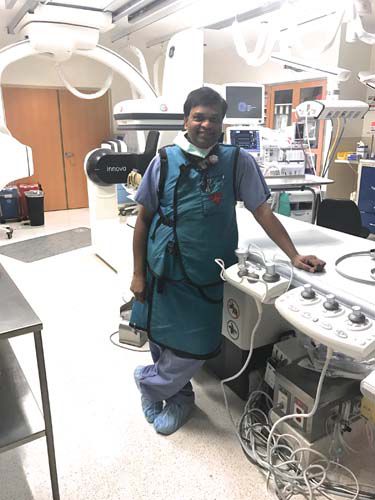
Some 500,000 Americans are diagnosed with heart valve disease each year. For those among that group who live on the Treasure Coast, Dr. Prasad Chalasani and Debbie Mueller, director of cardiovascular services at the Heart Institute of the Lawnwood Regional Medical Center in Fort Pierce, have some very good news.
TAVR has come to the Treasure Coast.
TAVR – or trans-catheter aortic valve replacement – is, according to the American Heart Association, “a minimally invasive surgical procedure which repairs the valve without removing the old, damaged valve,” a process that is much less traumatic than old-fashioned surgery that required cutting open the chest.
Heart valve damage, largely a function of aging, can occur in any single valve or in any combination of all four heart valves. Aortic stenosis is by far the common cause. “Aortic valve stenosis (narrowing of the aortic valve) causes the heart to work harder to pump enough blood and can cause fainting, chest pain, heart failure, irregular heart rhythms or arrhythmias, cardiac arrest or death.”
Prior to the development of the TAVR procedure, valve replacements required an open-heart surgical procedure called a “sternotomy” in which the chest is splayed open to expose the heart. The TAVR procedure, however, is done by running catheters – usually through the femoral artery in the groin – up to the heart muscle with no incision in the chest at all. This helps dramatically improve a patient’s recovery time.
Chalasani believes TAVR procedures “will totally replace” the more traditional surgical approach “in 95 percent of cases.”
The procedure isn’t rocket science, of course – it is actually more complicated than that. So it is not surprising that gaining accreditation to do the operation is an arduous and time-consuming process. “A successful TAVR procedure requires a merging of widely different skills, including personnel experienced with guide-wire skills and fluoroscopic imaging as well as vast knowledge of open vascular approaches, cardiac structures and aortic root anatomy,” according to the National Institutes of Health.
“We started preforming TVAR procedures sometime in April of this year and we have done 20 so far,” Chalasani says. “All 20 of them are doing quite well.” He says that, worldwide, the rate of complications due to TAVR procedures is an astonishingly low 2 percent.
That’s likely because while a traditional sternotomy “is a three-to-four-hour open operation, this procedure takes about 40 minutes.” Plus, patients tend to be up and walking far sooner after a TAVR procedure than after open heart surgery.
The TVAR approach delivers a fully collapsible tissue replacement valve – usually from a cow or a pig – to the valve site through a catheter. Once the new valve is expanded, it pushes the old valve leaflets out of the way and takes over the job of regulating blood flow.
Originally approved solely for patients deemed at “high” or even “extreme” risk for open heart surgery, in August of this year the FDA approved TAVR procedures for patients with aortic valve stenosis who are at “intermediate” risk of death or complications associated with open-heart surgery.
Chalasani expects the procedure will be open to all in the very near future.
Dr. Prasad Chalasani’s offices are at 1900 Nebraska Avenue, Suite 9 in Ft. Pierce. The phone number is 772-465-4499. Debbie Mueller’s office is at 1700 South 23rd Street in Ft. Pierce and the phone number is 772-468-4543.



